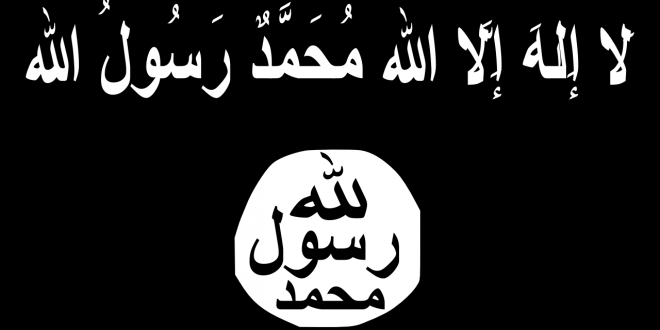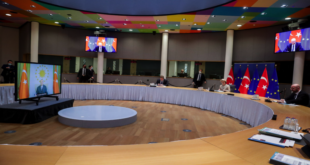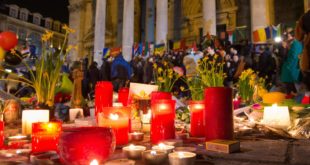The ability of the Islamic State to expand its influence and territorial control depends on a range of state and social factors specific to each country in the region.
Following the recent killings of Egyptian Copts in Libya and the attack on Tunisia’s Bardo Museum, the ability of the Islamic State to further project its power and appeal in the Middle East and beyond has been much discussed. Whether such fears come to reality, however, will depend on two main factors.
The first and most important of these will be the extent of the organisation’s resilience in the face US-led campaign against its strongholds in Iraq and Syria. The second concerns the specific context of each country in the region, with two key variables: the level of state stability, on the one hand, and the local strength of rival Jihadi groups like al-Qaeda, on the other hand.
Iraq-Syria: Resisting the onslaught
Territorial control over Western Iraq and Eastern Syria is IS’ most precious asset. First, because this control is the mainstay of the group’s main selling point – that is, its claim to be not a mere “movement” like its rival, al-Qaeda, but a state. Secondly, as the trans-border character of IS’ territorial control underpins the pretensions of its leader Abu Bakr al-Baghdadi to be recognised as the new Caliph. Thirdly, these territories provide IS with oil, crops, opportunities for extortion and other resources that allow the organisation to sustain its military effort, organise governance, and buy new allegiances at home and beyond.
Although IS’ territorial expansion has been largely halted and, in some cases, reversed over the last months, it is far too early to announce the coming collapse of the organisation. In Iraq, the organisation is unsurprisingly suffering setbacks in the face of the combined efforts of the Iraqi Armed Forces (IAF), Shia militias, Kurdish Peshmergas, Iranian Revolutionary Guards Corp and US-led air campaign.
However, formidable military and political challenges lie ahead. Militarily, recent inroads into IS’ Sunni strongholds – principally concerning the Baiji refinery and battle for Tikrit – should not obscure two important facts: first, IS remains able to deal hard blows to its enemies, as illustrated last week by a fierce attack in Ramadi; secondly, the forthcoming battle for Mosul will be made far more difficult than the seizure of Tikrit by the size of the city and the risk of civilian casualties, since most of the one million residents remained in place after IS’ takeover last June.
Politically, a durable stabilisation of the country will require the reintegration of the Sunnis into the Iraqi state, a task that is made more daunting then ever by recent developments. However unpopular IS has become among the population it pretends to defend, the ongoing campaign against the organisation is adding to the existing sectarian resentment due to the abuses committed by Shia militias against Sunni civilians.
In addition, the substantial increase in the influence of Shia militias, and of Iran, within the Iraqi state since the IAF collapse of June 2014 is likely to pose structural obstacles to reconciliation. In that respect, the significance of the participation of Sunni tribes in the anti-IS campaign should not be overstated: recruiting rank-and-file auxiliaries is an entirely different matter from engineering genuine political inclusion.
This point, of course, was illustrated in 2008, when Sunni tribes in Iraq’s Anbar province were paid by the “Awakening” programme to tackle the presence of al-Qaeda, yet subsequently remained excluded and even oppressed by the Iraqi state. If the lessons of 2008 are not learned this time around, the outcome of further instability down the line can hardly be expected to be any different either.
In Syria, the US-led air campaign has resulted in IS’ retreat from Kobane in the face of the Kurdish Popular Protection Units (YPG) and their Arab rebel allies. The jihadists have suffered similar setbacks in the south of the Hassake province, where they are battling the YPG as well as Asad’s army and tribal auxiliaries. These battles have resulted in IS’ loss of an important communication line between Syria and Mosul.
Coalition airstrikes against oil infrastructures and the broader deterioriation of the economic situation within IS strongholds have also degraded the organisation’s funding. Over recent days, IS’ weakening has been exploited by the rebels, who scored minor victories against the group in the northern countryside of Aleppo and the Qalamun mountain, north of Damascus.
Military defeat and such strain on resources, in addition to low-scale guerrilla operations by remnants of rebel groups defeated last year by IS in eastern Syria, are also creating internal tensions. The extent to which these are affecting IS is suggested by recent reports of members fighting one another, trying to defect, or being executed on allegation of treason.
Growing difficulties are most likely to generate motivational problems among such IS members as the pragmatic locals who joined the group out of hope for security and salaries, as well as those among foreign volunteers who are more attracted by the prospect of living a better life in God’s Kingdom on Earth than by the hardships of warfare under US airstrikes.
In spite of these reversal of fortune, IS’ military potential in Syria remains considerable, as demonstrated by its current counter-offensive against the YPG near the border town of Ras al-‘Ayn, and its continued ability to challenge regime control over the central desert. By launching attacks across the latter from its strongholds along the Euphrates, IS aims to seize gas fields, weaken its rebel rivals on the outskirts of Syria’s central corridor, and maintain its relevance within the struggle against Asad and Hizbullah by sending reinforcements to the Qalamun mountains north of Damascus.
With its overwhelming Sunni majority and Alawite, Iran-backed regime, Syria actually provides IS with a structurally more promising environment than Iraq. In the short-term, the organisation will continue its (currently only moderately successful) attempts at recruiting new affiliates among rebel groups by playing on intra-insurgent divisions and offering financial incentives. In the longer term, the best-case scenario for IS would be a local or general collapse of anti-Asad insurgents. Indeed, as happened in Iraq, the resulting vacuum would bolster the organisation’s claim that it is the only credible defender of the Sunnis’ rights in the country.
Lebanon: Beyond local spillover?
IS is already operating on Lebanese territory, although as a result of a localised spillover of the Syrian conflict, rather than as a formal decision to expand across the border: the group has not established a wilaya (“province”) for Lebanon yet, nor has it appointed an emir there. IS’ presence on the Lebanese side of the Anti-Lebanon mountains essentially results from the reconquest of the main cities of the Qalamun area by regime forces and Hizbullah in late 2013-early 2014, which forced the rebels (including, to this date, possibly more than one thousand IS fighters) to seek refuge westwards.
On the other side of the Anti-Lebanon mountains lies the northern Beqaa Valley, which is home to anti-Asad Lebanese Sunni communities and Syrian refugees, but also Shia-majority Hizbullah strongholds. The region has therefore provided Syrian insurgents with supporters, supplies, safe havens, and opportunities to punish the Lebanese Shia militia for its involvement in Syria.
Attempts by the Lebanese Armed Forces (LAF) and Hizbullah to clamp down on the Syrian insurgents’ use of Lebanese territory as a back office have led to a series of clashes. The most serious occurred when IS and the al-Qaeda-affiliated Nusra Front – at war with each other across Syria, but until recently maintaining a modus vivendi in the Qalamun – stormed the town and refugee camp of Ersal in August 2014.
Although they were eventually driven out, they captured dozens of Lebanese soldiers and policemen, four of whom were subsequently executed. Dozens of refugees were also killed during the recapture of the town by the LAF. In the subsequent months, IS has adopted a lower profile in the region while establishing a shadowy sharia court system and trying to endear itself to locals and refugees by cracking down on crime in the region.
In late 2013 and early 2014, IS members were also reportedly involved, alongside al-Qaeda-related elements, in a series of car-bombing against Hizbullah across Lebanon, including Beirut. The militant cells were rapidly dismantled due to the cooperation of all major Lebanese political factions: although overtly hostile to Hizbullah and its involvement in Syria, the anti-Asad Sunni politicians of the 14th of March movement know well that the rise of Jihadi militancy inside Lebanon would necessarily occur at their own expense.
In addition to improvements in the LAF’s equipment thanks to Western and Saudi support, as well as to efficient counter-terrorist measures, another obstacle to IS expansion into Lebanon is the weight of the Nusra Front. The latter remains the most powerful group in the Anti-Lebanon mountains and enjoys a denser network of relations with Jihadi circles across the country.
The militants that clashed with the LAF in and around Tripoli last October were reportedly tied to the Nusra Front, and it is the latter that claimed responsibility for a double-suicide attack carried out in January 2015 in an Alawite neighbourhood of the same city. Very recently, the Nusra Front and other rebel groups launched a military offensive against IS in the Anti-Lebanon; if successful, this offensive would sever IS’ bridgehead in the Beqaa Valley from the Syrian hinterland.
One should not hastily dismiss the possibility of increased IS activism in Lebanon, however. The country remains a tempting prey for Jihadis for two main reasons: first, targeting Hizbullah and its allies inside the country confers considerable prestige upon the perpetrators among their Syrian popular base due to the role of the Shia militia in shoring up Asad; secondly, Lebanon harbours a large pool of disenfranchised Sunnis who resent economic marginalisation and what they perceive as Hizbullah’s domination over the state, and do not feel represented by mainstream Sunni politicians.
In this context, going West into Lebanon might well be a credible option for IS if the organisation has to offset, at least symbolically, major territorial losses in Iraq and Syria.
The wider region
Other eastern Arab countries – that is, Jordan, the Gulf Cooperation Council (GCC) monarchies and Yemen – constitute far less favourable venues of expansion for IS, although for very different reasons. With the exception of Yemen, all of these states are stable and exert tight control over their territory, thereby offering no space for IS’ bottom-up state-building project.
A neighbour of Syria, a major recipient of refugees, and the homeland of several thousand foreign fighters operating within the ranks of IS and the Nusra Front, Jordan is relatively more exposed than the other countries mentioned above. It is also significantly poorer than the oil and gas-rich GCC members and therefore more prone to social unrest. In the southern city of Ma’an, where endemic poverty has, for decades, translated into episodic outbursts of popular dissent, anti-state sentiments have recently been expressed through displays of sympathy for IS.
The organisation does not seem to have any meaningful organisational presence in the country, however, as it supporters face not only tight policing, but also powerful ideological challengers in the persons of state-tolerated pro-Nusra luminaries like Abu Muhammad al-Maqdisi and Abu Qatada al-Falastini, in addition to the revulsion provoked by the immolation of Jordanian pilot Mu’adh al-Kassasbeh at the hands of IS last February.
For the time being, IS’ threat to Jordan is limited to the possibility of minor cross-border attacks and terrorist operations. Both scenarios have already materialised in Saudi Arabia, with the state losing an army officer along the Iraqi border in January, while in November IS-linked militants were reportedly behind the killing of seven Shia worshippers in the Eastern Region, the assassination of a Danish citizen in Riyadh, and possibly other recent attacks against American citizens and a security official.
IS activities in Yemen also remain extremely low-profile and apparently limited in scale. This might seem paradoxical: the failure of the state and rising sectarian tensions following the takeover of the Zaidi Huthi rebels at first glance provides a favourable context for IS expansion. The main obstacle in Yemen, however, is the long-standing presence of a powerful rival, namely, al-Qaeda in the Arabian Peninsula, which established a short-lived emirate in the governorate of Abyan in 2011-12. Due to its entrenchment in the country, AQAP was best positioned to present itself as the spearhead of Sunni resistance to the newly established Zaidi-Shia domination. Of course, AQAP’s possible failure to achieve meaningful results in that respect would make it vulnerable to IS’s attempts at stirring defections within its ranks.
Prospects for further IS expansion in the Arab East thus seem fairly limited at the moment, given the weakening of the organisation within its core territories, on the one hand, and the obstacles it faces beyond the Syrian and Iraqi borders, on the other hand.
We are far from the endgame, however. The root causes of the organisation’s revival after its defeat in Iraq at the end of the last decade – namely, Sunni marginalisation and state failure in Iraq and Syria – still seem very far from being meaningfully addressed. In Syria, in particular, further Western rapprochement with the Asad regime would provide IS with a political compensation for its military losses.
Indeed, the vindication of the group’s anti-Western rhetoric would facilitate the recruitment of new affiliates among rebel groups, a task that would be made even easier if new insurgent defeats allowed IS to pose as the true flag bearer of the Syrian revolt. It has now become commonplace — and accurate — to say that IS’ main strength is the weaknesses of its enemies. From that point of view, the profoundly dysfunctional nature of the Middle Eastern political order provides little ground for optimism.
** This article was written before the attacks on Houthi Mosques in Sanaa, Yemen, for which the Islamic State has claimed responsibility **
The views expressed in this article are the author’s own and do not necessarily represent those of ForMENA.
 ForMENA Council for MENA affairs
ForMENA Council for MENA affairs




